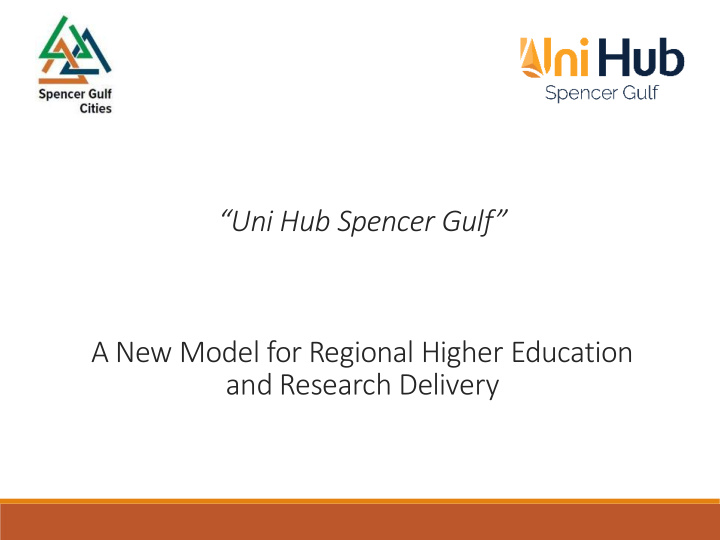



“Uni Hub Spencer Gulf” A New Model for Regional Higher Education and Research Delivery
Upper Spencer Gulf - Future Industries Current transition from traditional heavy industry base. Opportunity to build on comparative strengths and diversify economy: Renewable Energy – solar PV and CST, pumped hydro, wind, tidal, hydrogen, storage Arid Agriculture and Innovation – Sundrop, Betatene, Muradel, Sterile Insect Facility Mining and Minerals Processing – Nyrstar, Oz Minerals, GFG Alliance Defence – Cultana expansion Intermodal Transport and Logistics – port/rail/air/road Event and Nature Based Tourism – conferences, marine tourism Regional Service Centres – govt services, health, aged care, education, retail = critical to improve higher education, skills and research capabilities in our region to support these emerging sectors.
“... education is the future foundation of economic and community growth, innovation and entrepreneurship in the Upper Spencer Gulf …” “… a clear need to improve skills capacity in the USG in order to realise a strong and prosperous economy..” “... the lack of scientific and technical capability in the region is a key barrier to future growth and economic diversification ..” O’Neil M (2012) The Common Purpose – Advancing the Economic and Social Development of the Upper Spencer Gulf; A report prepared by the South Australian Centre for Economic Studies for the Upper Spencer Gulf Common Purpose Group KPMG (2012) Upper Spencer Gulf Heavy Industry Hub. Houghton K (2014) Upper Spencer Gulf Stocks and Flows - Residents, Employment and Socio-Economic Connections across the Upper Spencer Gulf, report prepared by , Strategic Economic Solutions for Upper Spencer Gulf Common Purpose Group
Key Education and Workforce Issues ❑ Existing and future skills shortages ❑ Lack of technical, professional and scientific capacity within the USG. ❑ Fly-in, Fly-out research and expertise – no local or lasting capacity generated. ❑ Significant economic transition – retraining existing workforce. ❑ Upskilling – lack of locally available VET-uni pathways, postgrad, accreditations. ❑ Unemployment, underemployment - particularly youth, increase in 457 visas. ❑ Online study completion rates very low compared to blended delivery that includes some face to face student and tutorial support. ❑ Lack of critical population mass in the USG to sustain traditional university – a new model required.
Educational Disparity 2016 Census - Education Levels Whyalla % Port Pirie % Pt Augusta % SA % Australia % Hold a bachelor degree or higher 8.6 7.1 7.9 18.5 22.0 Currently undertaking university study 5.7 4.3 3.1 16.2 16.1 Vocational level qualifications 28% 25% 24% 25% 28%
Upper Spencer Gulf – Tailored Model Newcastle and Wollongong – Industrial transition underpinned by strong university-industry-community partnerships Geraldton WA and Cooma NSW - Community Tertiary Education Centre (COTEC) models Upper Spencer Gulf approach – tailored to our region: o Includes undergraduate, postgraduate, VET and research support o No duplication of existing local courses where industry needs being met o Tailored to smaller population and tri-city geography o A presence in each of the three cities – commence in Port Pirie, then Port Augusta o Opportunity for specialisations across the three cities o Better local coordination of university interest in the USG o Leverage existing industry engagement (ie Industry Leaders Groups, industry clusters) o Service local demand for post-graduate qualifications and professional up-skilling
Our Goals 1. Build lasting research/technical capacity in the region 2. Local decision making - what is delivered, how, when, by whom and quality 3. Expand higher education and research offerings delivered in the region 4. Additional 2-5% new students engaged in higher education in the USG 5. Stronger industry/community/university partnerships 6. More efficient use of resources, collaborative physical presence 7. Higher education and research as an industry as well as an enabler
Responsibility of Uni Hub ❑ Local school and industry engagement ❑ Student recruitment, enrolment, student pastoral care ❑ Local facilities - study spaces, tutorial rooms, NBN broadband and IT support, computing facilities, printers, student amenities ❑ Local coordination and input into courses with industry and academic partners ❑ Local tutorial support (local tutors drawn from industry) ❑ Local coordination of industry-embedded placements ❑ Local support for researcher exchanges and specialist visiting researchers ❑ Coordination of local industry scholarships ❑ Facilitating local access to demonstration and pilot research sites ❑ Facilitate research partnerships between industry and research proponents
Responsibility of University Provider Course content and quality as contracted Delivery of undergraduate and postgraduate courses - blended Award of qualifications Online development and teaching Supervision of Higher Degree Research and pHD students Provision of required software and systems access for students and local uni study centre staff
Milestones to Date Business case developed 2015 by Strategic Economic Solutions, peer reviewed SACES – model based on student fee- sharing split, break even by year 6/7. Will require strong Government support as is operating in market failure. National EOI in 2017 for Project Partners – Central Queensland University, Adelaide University, Flinders University plus TAFESA, Academy Curio, Local Government, Industry Leaders Group and Regional Development Australia. $1.1 million Aust Govt grant seed funding through ‘Upper Spencer Gulf Regional Jobs and Investment Package’. $1.9 million Aust Govt operational grant funding through ‘Regional Study Hubs’ program. $1.0 million Council, business and university support leveraged. New ‘Uni Hub Spencer Gulf’ board established and staff engaged. Flinders University, CQ University, Adelaide University - MOU as delivery partners. First student intake in Port Pirie 2019 – 65 students. Port Augusta presence from 2020.
Recommend
More recommend